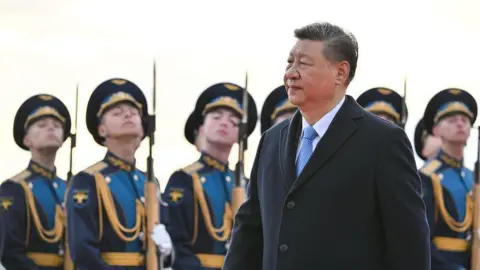The long-standing trade tensions between the United States and China appear to be easing as representatives from both nations prepare to engage in high-level talks in Switzerland. This will mark the first significant meeting since President Donald Trump imposed extensive tariffs on Chinese imports in January. In response, Beijing retaliated with its own set of tariffs, resulting in a tumultuous standoff that saw both nations escalate trade barriers. Currently, American tariffs on Chinese goods stand at an unprecedented 145%, while some exports from the U.S. facing duties have risen to 125%.
The negotiations taking place this weekend are crucial, serving as a notable shift in the political climate surrounding the two economic powerhouses. Analysts have been curious about the reasons behind this new willingness to negotiate. Despite the earlier rhetoric and tit-for-tat exchanges, it seems both sides are beginning to seek a solution to their escalating disagreements.
Stephen Olson, a senior visiting fellow at the ISEAS-Yusof Ishak Institute in Singapore, remarked on the psychological dynamics at play, stating, “Neither side wants to appear to be backing down.” The current talks reflect both parties’ assessment that they can advance discussions without losing face or appearing weak. Despite this mutual interest in resolution, there are still underlying tensions, as evidenced by China’s foreign ministry spokesperson Lin Jian emphasizing that the discussions were initiated at the request of the U.S. Furthermore, the Chinese commerce ministry claimed it was simply responding to calls from American businesses, meanwhile, Trump’s administration pointed to China’s increased eagerness to engage in talks, interpreting it as a sign of economic struggle.
As the lead-up to the talks progresses, the tone from the President softened. Trump commented, “We can all play games. Who made the first call, who didn’t – it doesn’t matter,” emphasizing instead the significance of what will transpire during those discussions. This meeting occurs against the backdrop of Chinese President Xi Jinping’s visit to Moscow for Victory Day festivities, where he joined leaders from various nations, further emphasizing China’s role in the global landscape. This strategic diplomatic maneuver allows China to project an image of confidence ahead of the negotiations.
Despite both nations maintaining tough stances, the economic realities pushed by the existing tariffs are proving burdensome. U.S. tariffs aim to bolster American industrial strength, particularly as Trump promised that they would not only enhance profitability but also create domestic job security. On the flip side, however, Beijing has committed to fighting back against these tariffs. Nevertheless, data from China shows evidence of a decline in industrial output, with manufacturing activity reaching its lowest levels since December 2023. Reports highlight that Chinese exporters are struggling due to tariffs, and although they repeat a rhetoric of defiance, the reality is that they are increasingly seeking out alternative markets.
The economic pressures on both sides are undeniable. Trump has candidly acknowledged the impending impact of tariffs on American consumers, predicting that families might have to accept fewer toys at higher prices. Amidst economic uncertainty, Trump’s approval ratings have dipped, with a significant portion of the public expressing concern over the implications of tariff policies. As both countries grapple with domestic pressures from anxious markets, the upcoming Geneva discussions are seen as a critical step toward restoring some level of stability and reassurance.
However, there are cautious voices suggesting that while the talks may open doors for dialogue and exchange, they are unlikely to result in an immediate resolution of the complex issues that have defined U.S.-China trade relations. Historically, substantive negotiations take time, and many significant topics, including Chinese government subsidies and international collaborations, remain unresolved. The suggestion is that while Geneva may produce initial statements of goodwill, actual progress on pressing issues will require more extensive discussions down the line.
In conclusion, as the U.S. and China prepare to engage each other in talks, the motivations and pressures on both nations underscore the complexity of their relationship. The importance of these negotiations cannot be overstated, as they may not only shape trade dynamics but also influence broader geopolitical strategies in a rapidly evolving global landscape.



